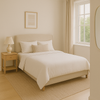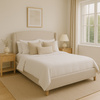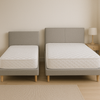Single VS Small Double Mattress: What's the Real Fit?
- by Mariam Labadze
Quick Answer
Single mattresses (90x190cm) suit solo sleepers in compact spaces—children, teenagers, students, or adults in studios—providing adequate personal space whilst maximizing room functionality. Small doubles (120x190cm) offer 30cm additional width accommodating couples in constrained bedrooms or generous solo sleeping, though the 60cm per person proves snug for two adults long-term. Choose singles for children's rooms (typically until age 12-14), guest rooms prioritizing space efficiency, or any solo sleeper valuing floor space for other furniture. Select small doubles for couples in flats under 2.7x3m bedroom dimensions, solo sleepers wanting luxurious space, or guest rooms occasionally hosting couples. Price differences prove minimal (£50-£100 typically), making size selection primarily spatial and functional rather than budgetary. Consider sleeper height (those over 180cm might need 200cm length), sleeping position (side sleepers need more width), and five-year lifestyle projection before committing.
[toc]
Understanding the Dimensions
Single Mattress Specifications – At 90x190cm (3ft x 6ft3), singles represent the standard solo adult sleeping size in UK markets. The 90cm width provides adequate space for average-build adults sleeping on backs or sides, though broader-shouldered individuals or active sleepers might feel somewhat constrained compared to wider alternatives.
The 190cm length suits individuals up to approximately 175cm height comfortably, allowing standard pillow placement without feet overhanging mattress ends. Taller individuals might experience foot overhang depending on sleeping position and pillow loft affecting actual usable length.
Weight capacity typically ranges 100-120kg for quality singles, adequate for most individual adults though heavier users should verify specific mattress weight ratings ensuring appropriate support and longevity.
Small Double Dimensions – The 120x190cm (4ft x 6ft3) small double—sometimes called "three-quarter" size—bridges singles and standard doubles. The 120cm width theoretically accommodates two adults at 60cm each, though this proves narrower than single bed width making long-term couples' use somewhat cozy for average-sized adults.
For solo sleepers, the additional 30cm compared to singles provides luxurious space allowing unrestricted movement, starfish sleeping positions, or simply enjoying generous personal territory that cramped sleeping never permits.
The identical 190cm length matches singles, meaning height suitability remains consistent across both sizes—adequate for average UK population heights but potentially restrictive for taller individuals regardless of which size selected.
Room Space Requirements
Minimum Dimensions for Singles – Bedrooms as compact as 2.1x2.4m technically accommodate single beds with minimal circulation, though these tight dimensions suit only children's rooms or true emergency guest spaces. More comfortable proportions around 2.4x2.7m allow bedside tables and reasonable movement without navigating tight spaces that genuinely small rooms create.
Singles prove ideal for maximizing sleeping capacity in limited spaces—fitting two singles where one standard double would consume equivalent width whilst providing separate sleeping surfaces valuable for siblings sharing, guest flexibility, or adult roommates preferring individual beds over shared sleeping.
Calculate actual usable space after accounting for door swing clearances, radiator positions, built-in wardrobes, and any architectural features consuming floor area before assuming room dimensions technically meeting minimums prove practically adequate.
Small Double Space Needs – Minimum room dimensions around 2.7x3m accommodate small doubles with basic furniture, though 3x3.3m provides more comfortable proportions for complete bedroom functionality including storage, circulation, and comfortable daily use.
The extra 30cm width compared to singles proves significant in compact rooms—this might represent difference between fitting a small desk or requiring eliminating workspace entirely. Measure carefully and use painter's tape outlining full bed dimensions on floors visualizing actual space consumption before purchasing.
Consider that room shapes affect furniture placement significantly. Narrow rectangular rooms might accommodate small doubles lengthwise but prove challenging for widthwise placement, whilst square rooms offer more flexibility positioning beds optimally relative to doors, windows, and other architectural features.
Who Should Choose Singles
Children and Teenagers – Singles suit children from cot transitions (around age 2-3) through mid-teenage years. The size provides adequate growing room without excessive bed dominance in children's rooms where play space matters equally to sleeping accommodation.
Most children comfortably use singles until ages 12-14, though early growth spurts, tall parents suggesting eventual tall children, or preference for generous sleeping space might warrant earlier transitions to small doubles or standard doubles.
The size also simplifies bedding costs—single duvets, sheets, and mattress protectors cost significantly less than larger sizes, relevant consideration for parents managing multiple children's bedding needs where cumulative costs matter substantially.
Student Accommodation – University halls and student flats typically feature singles reflecting the compact spaces and budget constraints that student housing represents. Singles maximize bedroom functionality allowing desks, storage, and living space that larger beds would compromise.
The size suits the transient nature of student living where furniture rarely moves between accommodations and space efficiency trumps sleeping luxury during these temporary, budget-conscious life phases.
Solo Adults in Studios – Studio apartments and bedsits benefit tremendously from singles' space efficiency. The compact footprint allows defining separate sleeping and living zones within single rooms where larger beds would dominate entirely, preventing functional space division.
However, solo adults in studios should honestly assess whether the space savings justify sleeping compromise. If sleeping represents primary room function with minimal daytime living space needs, small doubles might prove worthwhile despite spatial dominance.
Guest Room Efficiency – Guest bedrooms prioritizing versatility and multi-functionality benefit from singles' modest footprint. The space saved allows incorporating desks, reading chairs, or exercise equipment making rooms useful daily rather than empty most of the year awaiting occasional guests.
Two singles provide more guest flexibility than one double—accommodating couples, friends, siblings, or solo guests with equal ease whilst offering reconfiguration possibilities that fixed double beds cannot match.
When Small Doubles Make Sense
Compact Couples' Solution – Couples in flats with genuinely constrained bedroom dimensions (under 2.7x3m) where standard doubles prove spatially impossible benefit from small doubles providing couples' accommodation without standard double spatial requirements.
However, be realistic about long-term comfort. At 60cm width per person versus 67.5cm in standard doubles or 75cm in kings, small doubles require closeness that established couples comfortable with proximity tolerate better than those valuing personal sleeping space.
Partners with significant height or build differences might find small doubles particularly challenging—the smaller partner's 60cm proves adequate while larger partner feels genuinely cramped. Test comfort in showrooms lying side-by-side before committing to ensure realistic assessment rather than optimistic assumptions.
Luxurious Solo Sleeping – Solo sleepers wanting generous personal space without committing to full standard double dimensions find small doubles offering meaningful upgrade over singles without excessive spatial demands that standard doubles represent in modest bedrooms.
The extra 30cm allows comfortable starfish sleeping positions, room for pets sharing beds, or simply psychological comfort from generous personal territory that cramped sleeping never provides regardless of technically adequate single dimensions.
Side sleepers particularly benefit from additional width—this sleeping position consumes more horizontal space than back sleeping, making width upgrades more impactful for comfort than for those sleeping primarily on backs.
Occasional Couples Hosting – Guest rooms hosting both solo travelers and couples benefit from small doubles' flexibility. Solo guests enjoy generous space whilst couples accommodate adequately for short visits where intimacy proves acceptable given temporary nature rather than nightly reality.
This compromise avoids dedicating guest room space to full standard doubles used only occasionally whilst still providing reasonable couples' accommodation when needed.
Practical Comfort Considerations
Personal Space Calculations – Singles provide 90cm personal width—adequate for average adults but feeling restrictive for broader builds or very active sleepers requiring movement space. Small doubles' 120cm gives solo sleepers luxurious space, whilst couples get 60cm each—less than singles provide individually, requiring proximity tolerance.
Consider body width honestly. Broad-shouldered individuals, or anyone over 100kg, should question whether 90cm singles or 60cm small double shares provide genuinely comfortable long-term sleeping rather than technically adequate but practically compromised solutions.
Movement and Sleep Position – Back sleepers consume minimal width making singles perfectly adequate. Side sleepers need more space given shoulder projection increasing effective width, whilst stomach sleepers fall between these extremes. Combination sleepers rotating through positions nightly benefit most from generous width accommodating all positions comfortably.
Active sleepers moving frequently during nights find additional width valuable preventing that restricted feeling that compact sleeping creates despite not actually waking from space limitations.
Temperature and Sharing – Couples in small doubles sleep closer with less personal space for heat dissipation. This proves lovely during winter but potentially uncomfortable in summer when proximity increases warmth that hot weather already challenges.
Consider bedroom temperatures and personal heat sensitivity when evaluating whether 60cm per person provides adequate comfort year-round or whether investment in larger sizes proves worthwhile for better sleep quality.
Budget and Value Comparison
Purchase Price Differences – Singles typically cost £50-£100 less than equivalent-quality small doubles—meaningful savings for budget mattress purchases but relatively minor differences in mid-range or premium categories where £50 represents small fraction of total investments.
This modest price difference means selection should prioritize spatial and comfort needs rather than cost savings that prove minimal in context of total bedroom furniture investments and years of daily use.
Ongoing Bedding Costs – Single bedding costs 20-30% less than small double equivalents across sheets, duvet covers, protectors, and duvets. These ongoing costs across mattress lifespans (8-10 years) accumulate meaningfully, particularly when purchasing quality bedding multiple sets allowing rotation during washing.
Calculate cumulative bedding costs over expected ownership—perhaps £200-£300 additional for small double bedding across decade of ownership. This matters more for budget-conscious buyers than those purchasing premium mattresses where bedding costs represent smaller proportions of total sleep investment.
Replacement Timing – Both sizes typically need replacing on similar schedules (8-10 years for quality mattresses) meaning lifespan differences don't affect value calculations. However, singles' lower purchase and bedding costs mean replacement expenses prove more manageable when that eventual necessity arrives.
Long-Term Lifestyle Projection
Five-Year Planning – Consider probable life changes within mattresses' typical lifespans. Singles suit current solo living but what about relationship possibilities? Small doubles accommodate solo sleeping but what if serious relationships develop requiring couples' solutions?
While impossible predicting life perfectly, honest assessment of probable directions helps avoiding premature size regret. Students likely remaining solo can confidently choose singles, whilst young professionals in relationships might anticipate eventual cohabitation suggesting small doubles or larger make better long-term investments.
Accommodation Changes – Factor in likely home moves within mattress lifespans. Purchasing singles for current studio might prove shortsighted if planning larger flat moves within 2-3 years where purchased mattresses prove inadequate for new situations despite remaining serviceable.
However, excessive future-proofing proves equally problematic—buying small doubles for hypothetical future relationships that might never materialize means years of solo sleeping in unnecessarily large beds consuming space that singles would have freed for other uses.
Growing Children – Children's singles eventually require upgrading as bodies outgrow dimensions. Most children comfortably use singles until early teens, though tall children or those experiencing early growth spurts might need upgrades sooner.
Small doubles offer longer usability potentially lasting through teenage years into young adulthood, though many teenagers appreciate upgrades to standard doubles when bedroom sizes permit, viewing larger beds as maturity markers and appreciating generous sleeping space.
Making Your Decision
Measure Everything – Document bedroom dimensions, door widths, stairwell clearances, and any access challenges affecting delivery. Use tape outlines on bedroom floors representing full mattress dimensions including thickness, visualizing actual space consumption before purchasing.
Verify that measurements account for bedding thickness—duvets add 5-10cm to bed widths when occupant sleeps in center, relevant for tight spaces where every centimeter matters for circulation and furniture placement.
Test Realistically – Visit showrooms lying in actual sleeping positions for several minutes rather than quick perch-and-bounce testing. Bring partners if purchasing for couples' use, lying side-by-side assessing realistic space adequacy rather than assuming specifications translate to comfortable reality.
Wear regular sleeping attire during testing if possible—pajamas and regular clothing affect space perception differently, and realistic testing provides better purchase confidence than showroom testing in restrictive day clothing.
Consider Professional Guidance – Speak with Moorcroft Beds' experienced team about specific situations, room dimensions, and sleeping preferences. Professional expertise helps navigating tradeoffs and identifying solutions that independent research might overlook.
The investment in quality mattresses warrants time ensuring correct sizing rather than discovering mistakes after delivery when returns prove inconvenient and costly despite generous policies designed protecting customers from genuine errors.
At Moorcroft Beds, we understand that correct sizing fundamentally affects sleep quality and bedroom functionality. Our range includes quality singles and small doubles ensuring finding perfect dimensions for your specific space, body, and lifestyle needs—because the right size makes all the difference between merely adequate sleeping and genuinely restorative rest.




